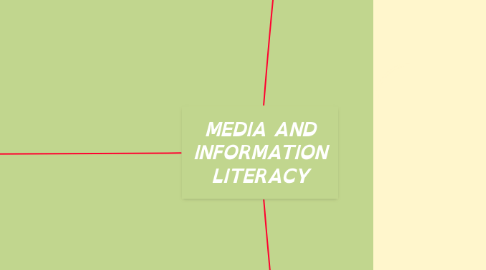
1. LESSON 1: WHAT IS MEDIA?
1.1. to spread that informations to others a message is passed on to others with the help of tools and devices. Media helps us in different dimensions.
1.2. THE COMMUNICATION PROCESS
1.2.1. SHANNON-WEAVER (MODEL OF COMMUNICATION)
1.2.1.1. SENDER ( S )
1.2.1.2. MESSAGE ( M )
1.2.1.3. CHANNEL ( C )
1.2.1.4. RECEIVER ( R )
1.2.1.5. THE FEEDBACK MECHANISM
1.2.1.5.1. knows if the message was effective.
1.3. MEDIA AS AN INFORMATION INDUSTRY
1.3.1. medium that includes
1.3.1.1. film
1.3.1.2. broadcast
1.3.1.3. publishing
1.3.1.4. photography
1.3.1.5. internet
1.3.1.6. mobile phones and tablets
1.3.2. used to deliver a media-constructed message becomes a media channel.
1.4. MEDIA AS AN CULTURE ENTERTAINMENT
1.4.1. language
1.4.2. history
1.4.3. traditional
1.4.4. climate
1.4.5. geography
1.4.6. arts
1.4.7. social
1.4.8. economic
1.4.9. political norms
1.5. KINDS OF MEDIA
1.5.1. Traditional Media
1.5.1.1. Print media
1.5.1.1.1. newspapers
1.5.1.1.2. magazines
1.5.1.1.3. comics
1.5.1.1.4. book
1.5.1.2. Broadcast Media
1.5.1.2.1. radio
1.5.1.2.2. television
1.5.1.3. Film or Cinema
1.5.1.3.1. huge screen
1.5.1.3.2. theaters
1.5.1.3.3. movie houses
1.5.2. New Media
1.5.2.1. Developed technologies
1.5.2.1.1. computers
1.5.2.1.2. mobile technology
1.5.2.1.3. smartphones
1.5.2.1.4. tablet devices
1.5.3. Social Media
1.5.3.1. Internet-maintained computer programs
1.5.3.1.1. facebook
1.5.3.1.2. instagram
1.5.3.1.3. twitter
1.5.3.1.4. youtube
1.6. MOBILE COMMUNICATIONS TECHNOLOGY
2. LESSON 2: MEDIA THEN AND NOW
2.1. BRIEF HISTORY OF MEDIA
2.1.1. pre-colonial traces
2.1.2. the print industry and filipino freedom
2.1.3. the european film support
2.1.4. the broadcast industry
2.1.5. local online media
2.2. PRE-INDUSTRIAL AGE
2.2.1. oral traditions
2.2.2. basic ancestor of information
2.2.3. communication flow
2.3. INDUSTRIAL AGE
2.3.1. evolution of factories
2.3.2. assembly line work flows
2.3.3. devising mechanism
2.4. ELECTRONIC AGE
2.4.1. heavily utilized electricity
2.4.2. information society
2.4.3. wireless technology
2.4.4. cable and satellite technologies
2.5. DIGITAL AGE
2.5.1. current age
2.5.2. information are readable
2.5.3. easily transferable zero-one computer binary
2.6. THE STATE OF MEDIA TODAY
2.6.1. from globalization to glocalizations
2.6.2. the local landscape
2.7. MEDIA OWNERSHIP
2.7.1. mainstream media
2.7.2. alternative and independent media
2.7.3. community media
2.7.4. state-owned media
3. LESSON 3: UNDERSTANDING MEDIA: AESTHETICS OF THE IMAGE, TEXT AND AUDIO
3.1. the key to appreciate information technologies and communication process is reading.
3.2. FRAMING AND READING
3.2.1. means to contruct , compose or imagine something, this is where form and content should be taken into consideration
3.2.2. NEWSPAPERS AND JOURNALISM
3.2.2.1. Newspaper
3.2.2.1.1. the communication of information on current events, prints, broadcast, internet or word pf mouth to a third party or mass audience
3.2.2.2. Journalism
3.2.2.2.1. the collecting, writing, editing and presenting of news in newspapers,magazines, radio and televisions
3.2.3. BOOKS, COMICS, MAGAZINES, AND THE PUBLISHING INDUSTRY
3.2.4. PHOTOGRAPHY AND TIMELESS IMAGE CONCEPTS
3.3. FRAMING AND LISTENING
3.3.1. RADIO AND EVOKING IMAGINATION
3.3.1.1. it is the most popular form of mass media all over the world
3.3.1.2. it is most practical form of media to have in rural or remote areas
3.3.1.3. "one chance" medium
3.3.1.3.1. you cannot go over information that has already been delivered in the way you would be able to do with the papers.
